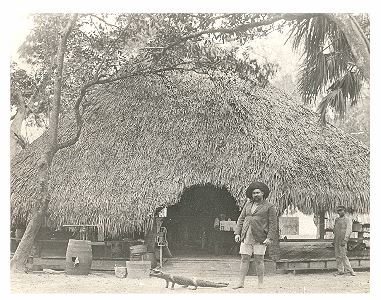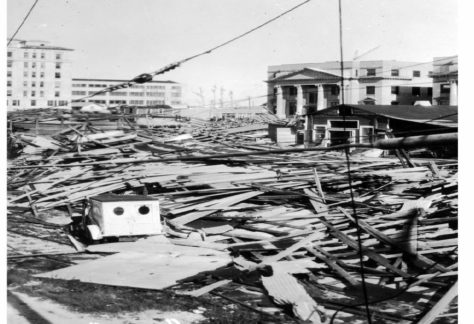Flagler Era through Boom-to-Bust

RAILROADS AND HOTELS
Henry Morrison Flagler first came to Florida from New York in 1878. His wife’s doctor suggested that her health might improve if she spent the winters in milder weather. The couple spent only one winter in Florida before Mary died in 1881. Two years later Flagler married his second wife, Ida, and took her to visit St. Augustine. Flagler quickly realized that there were neither enough hotels in the city, nor a reliable transportation system to get there. Flagler decided to return to St. Augustine in 1885 and build the grand Ponce de León Hotel. He knew that improved transportation would bring more visitors to his new hotel, so he bought the Jacksonville, St. Augustine and Halifax Railroad, the beginning of his railroad empire. Flagler continued to buy and build railroad lines, which eventually connected the entire east coast of Florida and became known as the Florida East Coast Railway.
In the early 1890s, Flagler visited south Florida and became enchanted by its beauty. After his visit, he decided to buy land in Palm Beach and construct a winter resort for wealthy tourists on the island. In 1894 he opened the Hotel Royal Poinciana overlooking Lake Worth, and two years later, the Palm Beach Inn (later renamed The Breakers) on the ocean beach. Flagler designed a city across Lake Worth to be the commercial and residential area to support the resort. This west side community incorporated as West Palm Beach in 1894. By then Flagler’s railroad reached the new town, bringing wealthy visitors and new residents to the area. It also shipped vegetables and fruits more quickly to northern cities, which helped the local economy. By 1896 Flagler extended the Florida East Coast Railway south to Miami, and in 1912 it reached Key West. The railroad was important for bringing more people and goods to Florida’s east coast.
HENRY PLANT
Henry Bradley Plant is often compared to Henry Flagler. While Flagler developed the east coast of Florida, Plant developed the west coast. Plant bought a string of railroads to connect Florida with the northern United States. He also began a steamship business to trade with the islands of the Caribbean. Just as Flagler had built fancy hotels, so did Plant. Most famous was his Tampa Bay Hotel, built in 1891, which became a National Historic Landmark and the home of the Henry B. Plant Museum.

ALLIGATOR JOE
Early visitors to Palm Beach had many activities to choose from while enjoying Florida’s mild winters. The local newspaper reported available activities daily. Visitors could golf, go fishing, and bathe in the pool or surf. They could go sailing to take in the sights of Munyon Island and the inlet. People could also visit a number of commercial tourist attractions. Among the most popular of these attractions was Alligator Joe’s alligator farm. At the farm, Alligator Joe entertained the crowds with his alligator wrestling. According to a 1903 newspaper account, Alligator Joe had “hundreds of alligators and crocodiles,” and the farm was only “about a mile from Royal Poinciana grounds on [the] cycle path.” Anyone desiring to walk or take a wheelchair ride could break up their trip with a stop at Joe’s to visit the reptiles and the occasional manatee.
Alligator Joe, born Warren Frazee on March 1, 1873, was a native Floridian. He came to this area from Jacksonville around 1898. Pictures of him show a large man with a long, flowing mustache. One newspaper account put Joe’s weight at 340 pounds. The same article also claimed that “Old Jumbo,” one of Joe’s alligators, was 2,000 years old and weighed 2,000 pounds. Most pictures show Joe in a wide-brim hat, with a pistol on his belt or a rifle in his hand, and alligators nearby. Close examinations of the pictures, however, reveal that some of those alligators were stuffed or newly dead.
Alligator Joe was known throughout the country. He had alligator farms or exhibitions in Chicago, Kansas City, and Denver. The Daily Tropical Sun reported that he employed Florida natives to manage his long-distance businesses. Joe also trapped manatees. In 1903 he sent a pair of manatees to the New York Zoological Society for display in their aquarium. By 1915 trapping manatees violated Florida law, but with the blessing of federal and
local government officials, Joe captured one more manatee for display at the Panama Exposition in San Francisco.
In March or April of 1915, Alligator Joe filled a number of train cars with “live alligators, manatees, and game fish of the sea” for the Panama Exposition and headed for San Francisco. Unfortunately, his alligator wrestling did not prove to be a good way to keep in shape. On May 30, 1915, Warren Frazee died of illness related to his obesity.

1928 HURRICANE
Hurricanes are important to understanding Florida’s history. On September 16, 1928, a great storm struck Palm Beach County, equal to a Category 4 hurricane. The deadly storm reached the shore with winds of 130 to 150 miles per hour, dropping more than eighteen inches of rain in less than twenty-four hours. This hurricane damaged almost everything in its path. The strong winds and heavy rainfall caused Lake Okeechobee to overflow and flood Belle Glade, Pahokee, South Bay, and Canal Point. The flooding and high winds killed more than 3,000 people in Palm Beach County. Yet the survivors overcame the disaster and rebuilt their cities and towns.
STRANGE BUT TRUE
Between the 1890s and 1920s, there were strict rules for women. One rule was that women could not show bare legs on the beach. They had to wear hose under their bathing suits. There was even a male beach patrol to make sure the rules were followed.

LAND BOOM AND BUST
By the 1920s, Florida had a population of 968,470 people. Just five years later, it reached 1,263,540. What caused such a rise in the population? The 1920s were called the Roaring ’20s. It was a time when a person’s wealth and success were measured by what he or she owned, and the economy was prospering. Many people had good jobs and could buy what they needed, so businesses were making money. Buying things on credit became popular. When you buy something on credit, you buy it now but pay for it later. People from all over the United States poured into Florida to buy land for cheap prices and then sell it for higher prices. These land speculators bought land to make a profit quickly. So much land was being bought in the 1920s that this period was called the Florida Land Boom.
During the boom, some people bought and sold land in Florida without ever coming to the state. They hired young, hard-working men and women to show their land to prospective buyers. Buyers would put a binder on the contract to buy the land. A binder was a non-refundable down payment for the land. The rest of the money was to be paid in thirty days. Non-refundable means that the buyers could not get their money back even if there was a problem with the sale. With land prices rising quickly, many buyers planned to sell again at a profit before the end of the thirty days.
Sometimes the buyers did not have enough money to pay for the land, only just enough to pay the binder. If they resold their land for profit before the end of the thirty days, they had no problem. But if they didn’t sell the land, they didn’t have enough money to keep it. They lost the land as well as the binder money they had paid.
As land was bought and sold at higher prices, serious problems developed. Housing costs went up in Florida. The railway system could not transport all the building materials needed to build homes and businesses in south Florida. The land prices stopped going up, so many of the speculators could not sell their property. Suddenly, there were thousands of acres of overpriced land without any buyers. Many landowners lost everything because they could not make the final payment for the land they had bought on a binder.
The Land Boom stopped almost as suddenly as it had started, turning the Land Boom into a Land Bust. To make matters worse, newspapers told readers to stay away from Florida because of unethical and illegal land deals.
In addition to these problems, several natural disasters hurt Florida’s economy, and the state went into a depression. During an economic depression, people lose their jobs and can’t afford to buy what they need. In turn, businesses cannot make enough money. In October 1929, the United States went into the Great Depression when the stock market crashed.

- What benefits did the Florida East Coast Railway provide to Palm Beach County?
- What are some events that led to the 1920s Florida Land Bust?
- Who was Henry Plant and what did he accomplish?
- What is the least likely reason the author wrote the article about Alligator Joe?
a. To discuss an early tourist attraction.
b. To let readers know about Alligator Joe.
c. To share Joe’s contribution to local history.
d. To address early wildlife preservation. - Which of the following is an activity mentioned in the article?
a. Going to Disney World.
b. Taking in the sights at Munyon Island.
c. Driving to Sea World.
d. All of the above. - What is Alligator Joe’s real name?
- What did a 1903 newspaper account say about Alligator Joe?
- According to the article, who was Old Jumbo?
In 1929 the Mediterranean fruit fly invaded Florida. A quarantine was put on the state that restricted farmers from selling their citrus to anyone outside of Florida. Citrus production was cut by about sixty percent.
